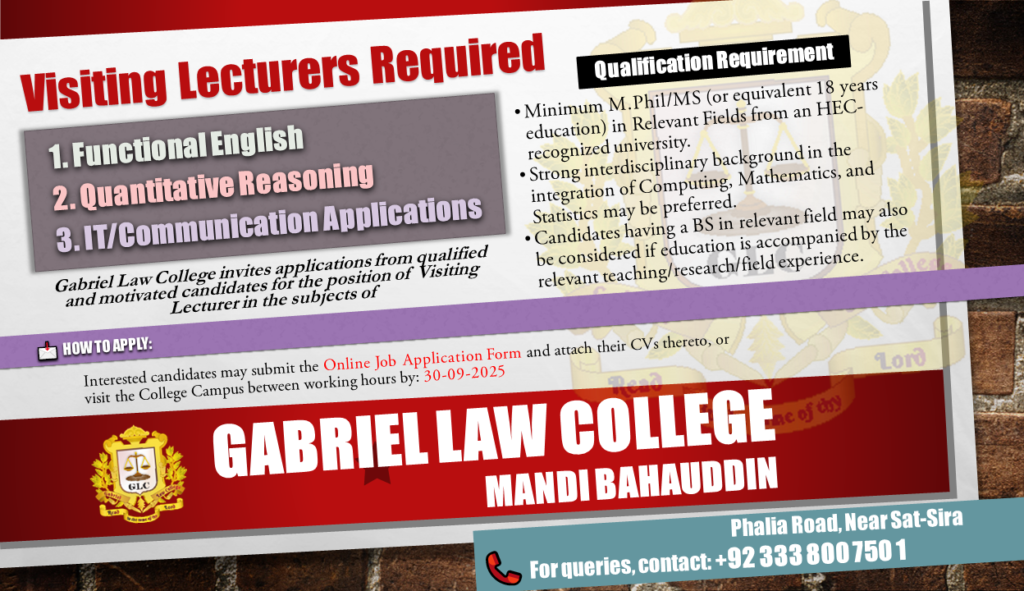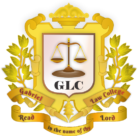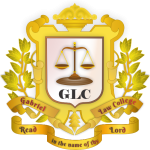Job Oppotunities

Quantitative Reasoning-I
Syllabus Outline
- Numerical Literacy
- Number system and basic arithmetic operations;
- Units and their conversions, area, perimeter and volume;
- Rates, ratios, proportions and percentages;
- Types and sources of data;
- Measurement scales;
- Tabular and graphical presentation of data;
- Quantitative reasoning exercises using number knowledge.
- Fundamental Mathematical Concepts
- Basics of geometry (lines, angles, circles, polygons );
- Sets and their operations;
- Relations, functions, and their graphs;
- Exponents, factoring and simplifying algebraic expressions;
- Algebraic and graphical solutions of linear and quadratic equations and inequalities;
- Quantitative reasoning exercises using fundamental mathematical concepts.
- Fundamental Statistical Concepts
- Population and sample;
- Graphical presentation of data
- Summarizing data;
- Measures of central tendency, dispersion and their applications;
- Rules of counting (multiplicative, permutation and combination);
- Basic concept of probability;
- Applications of a priori and relative frequency approach;
- Quantitative reasoning exercises using fundamental statistical concepts
Applications of Information and Communication Technologies
Syllabus Outline
- Introduction to Information and Communication Technologies:
- Components of Information and Communication Technologies (basic of hardware, software, ICT platforms, networks, local and cloud data storage etc.)
- Scope of Information and Communication Technologies (use of ICT in education, business, governance, healthcare, digital media and entertainment, etc.)
- Emerging technologies and future trends.
- Basic ICT Productivity Tools:
- Effective use of popular search engines (e.g., Google, Bing, etc.) to explore World Wide Web.
- Formal communication tools and etiquettes (Gmail, Microsoft Outlook, etc.)
- Microsoft Office Suites (Word, Excel, PowerPoint).
- Google Workspace (Google Docs, Sheets, Slides).
- Dropbox (cloud storage and file sharing), Google Drive (Cloud storage with Google Docs integration) and Microsoft OneDrive (Cloud storage with Microsof integration).
- Evemote (Note-taking and organization applications) and OneNote (Microsoft’s digital notebook for capturing and organizing ideas).
- Video conferencing (Google Meet, Microsoft Teams, Zoom, etc.).
- Social media applications (Linkedln, Facebook, Instagram, etc.).
- ICT in Education
- Working with learning management systems (Moodie, Canvas, Google Classrooms, etc.).
- Sources of online education courses (Coursera, edX, Udemy, Khan Academy, etc.).
- Interactive multimedia and virtual classrooms.
- ICT in Health and Well-being:
- Health and fitness tracking devices and applications (Google Fit, Samsung Health,
- Apple Health, Xiami Mi Band, Runkeeper, etc.).
- Telemedicine and online health consultations (OLADOC, Sehat Kahani, Marham, etc.).
- ICT in Personal Finance and Shopping:
- Online banking and financial management tools (JazzCash, Easypaisa, Zong PayMax,
- ILink and MNET, Keenu Wallet, etc.)
- Digital Citizenship and Online Etiquette:
- Digital identity and online reputation.
- Netiquette and respectful online communication.
- Cyberbullying and online harassment.
- Ethical Considerations in Use of ICT Platforms and Tools:
- Intellectual property and copyright issues.
- Ensuring originality in content creation by avoiding plagrism and unauthorized use of information sources.
Content accuracy and integrity (ensuring that the content share through ICT platforms is free from misinformation, fake news, and manipulation).
Functional English
Syllabus Outline
- Foundations of Functional English
- Vocabulary building (contextual usage, synonyms, antonyms and idiomatic expressions)
- Communicative grammar (subject-verb agreement, verbtenses, fragments, run-ons, modifiers, articles, word classes, etc.)
- Word formation (affixation, compounding, clipping, backformation, etc.)
- Sentence structure (simple, compound, complex and compound-complex
- Sound production and pronunciation
- Comprehension and Analysis
- Understanding purpose, audience and context
- Contextual interpretation (tones, biases, stereotypes, assumptions, inferences, etc.
- Reading strategies (skimming, scanning, SQ4R, critical reading, etc.)
- Active listening (overcoming listening barriers, focused listening, etc.)
- Effective Communication:
- Principles of communication (clarity, coherence, conciseness, courteousness, correctness, etc.)
- Structuring documents (introduction, body, conclusion and formatting)
- Inclusivity in communication (gender-neutral language, stereotypes, cross-cultural communication, etc.)
- Public speaking (overcoming stage fright, voice modulation and body language)
- Presentation skills (organization of content, visual aids and engaging the audience) Informal communication (Small talk, networking and conversational skills)
- Professional writing (businesse-mails, memos, reports, formal letters, etc.)

